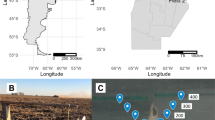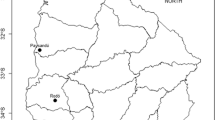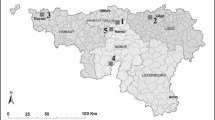Abstract
In a 6-year Hungarian study, ascospore density of Erysiphe necator in the air was monitored and related to three weather variables (temperature, relative humidity, and rainfall) and powdery mildew disease progress in two commercial vineyards. Temporal pattern in aerial density was also quantified. In total, 71 ascospore trapping periods were detected over the 6-year period from early April until end June. Across all years, 6.6 % of the total ascospores (0.5 % mean ascospore percent per day) were caught between the initiation of sampling in April and bud break, 62.2 % (1.6 %) from bud break to bloom, and 31.2 % (0.3 %) between bloom and the conclusion of sampling at the end of June. Hourly proportions of ascospores caught did not reveal diurnal patterns of spore release. All three weather factors (in the order of rainfall, relative humidity and temperature) correlated significantly with mean ascospore catches in each year. Mean hourly rainfall correlated best with mean hourly ascospore catches (correlation coefficient, r, ranged from 0.43 to 0.78) in both vineyards and in all years. First leaf and berry symptoms appeared between 7 and 24 May and between 25 May and 19 June, respectively, during the 6-year study. Disease started to progress slowly after the appearance of the first infected leaf followed by an exponential increase from early June. By the end of June, leaf and berry disease incidences ranged from 4.1 to 98.2 % and from 0.9 to 6.8 %, respectively, over the 6-year period. Leaf incidences showed significant relationship with corresponding cumulative numbers of trapped ascospore in five out of 6 years, which was described by three-parameter Gompertz functions in each year. Results were compared and discussed with previous observations.





Similar content being viewed by others
References
Anonymous. (1980). Operating instructions. Seven day volumetric spore trap. Rickmansworth, Hertfordshire, UK: Burkard Manufacturing Co. Ltd.
Burnham, K. P., & Anderson, D. (2002). Model selection and multimodel interference (2nd ed.). New York: Springer.
Caffi, T., Rossi, V., Legler, S. E., & Bugiani, R. (2011). A mechanistic model simulating ascosporic infections by Erysiphe necator, the powdery mildew fungus of grapevine. Plant Pathology, 60, 522–531.
Caffi, T., Legler, S. E., Rossi, V., & Bugiani, R. (2012). Evaluation of a warning system for early-season control of grapevine powdery mildew. Plant Disease, 96, 104–110.
Caffi, T., Legler, S. E., Bugiani, R., & Rossi, V. (2013). Combining sanitation and disease modelling for control of grapevine powdery mildew. European Journal of Plant Pathology, 135, 817–882.
Füzi, I. (1999). The occurrence of cleistothecial form of grape powdery mildew (Uncinula necator ⁄ Schw. ⁄ Burr.) and the process of formation of cleistothecia in Trans-Danubian vineyards. Növényvédelem, 35, 137–145 (in Hungarian with English summary).
Füzi, I., & Holb, I. J. (2007). The epidemiological role of the overwintering forms of grapevine powdery mildew fungus. Növényvédelem, 43(6), 237–245 (in Hungarian with English summary).
Gadoury, D. M., & Pearson, R. C. (1988). Initiation, development, dispersal, and survival of cleistothecia of Uncinula necator in New York vineyards. Phytopathology, 78, 1413–1421.
Gadoury, D. M., & Pearson, R. C. (1990). Germination of ascospores and infection of Vitis by Uncinula necator. Phytopathology, 80, 1198–1203.
Gadoury, D. M., Pearson, R. C., Riegel, D. G., Seem, R. C., Becker, C. M., & Pscheidt, J. W. (1994). Reduction of powdery mildew and other diseases by over-the-trellis applications of lime sulfur to dormant grapevines. Plant Disease, 78, 83–87.
Gadoury, D. M., Seem, R. C., Magarey, P. A., Emmett, R., & Magarey, R. (1997). Effects of environment and fungicides on epidemics of grape powdery mildew: considerations for practical model development and disease management. Viticulture and Enology Science, 52, 225–229.
Gee, L. M., Stummer, B. E., Gadoury, D. M., Biggins, L. T., & Scott, E. S. (2000). Maturation of cleistothecia of Uncinula necator (powdery mildew) and release of ascospores in southern Australia. Austalian Journal of Grape Wine Research, 6, 13–20.
Grove, G. G. (2004). Perenniation of Uncinula necator in vineyards of eastern Washington. Plant Disease, 88, 242–247.
Guerin, L., Froidefond, G., & Xu, X.-M. (2001). Seasonal patterns of dispersal of ascospores of Cryphonectria parasitica (chestnut blight). Plant Pathology, 50, 717–724.
Halleen, F., & Holz, G. (2001). An overview of the biology, epidemiology and control of Uncinula necator (powdery mildew) on grapevine, with reference to South Africa. South African Journal of Enology and Viticulture, 22, 111–121.
Hartman, J., & Beale, J. (2008). Powdery mildew of grape. Plant pathology fact sheet PPFS-FR-S-12:1–3. University of Kentucky, Cooperative Extension Service.
Hirst, J. M. (1953). Changes in atmospheric spore content: diurnal periodicity and the effects of weather. Transactions of the British Mycological Society, 36, 375–393.
Holb, I. J. (2008). Monitoring conidial density of Monilinia fructigena in the air in relation to brown rot development in integrated and organic apple orchards. European Journal of Plant Pathology, 120, 397–408.
Jailloux, F., Thind, T., & Clerjeau, M. (1998). Release, germination, and pathogenicity of ascospores of Uncinula necator under controlled conditions. Canadian Journal of Botany, 76, 777–781.
Jailloux, F., Willocquet, L., Chapuis, L., & Froidefond, G. (1999). Effect of weather factors on the release of ascospores of Uncinula necator, the cause of grape powdery mildew, in the Bordeaux region. Canadian Journal of Botany, 77, 1044–1051.
Jankovics, T., Komáromi, J., Fábián, A., Jäger, K., Vida, G., & Kiss, L. (2015). New insights into the life cycle of the wheat powdery mildew: direct observation of ascosporic infection in Blumeria graminis f. sp. tritici. Phytopathology, 105, 797–804.
Kapoor, J.N. (1967). Uncinula necator. CMI descriptions of pathogenic fungi and bacteria. 160.
Legler, S. E., Caffi, T., & Rossi, V. (2012). A non-linear model for temperature-dependent development of Erysiphe necator chasmothecia on grapevine leaves. Plant Pathology, 61, 96–105.
Lisek, J. (2013). Assessment of selected traits of 18 traditional wine Vitis vinifera cultivars in Central Poland. Polish Journal of Agronomy, 14, 18–21.
Lorenz, D. H., Eichhorn, K. W., Bleiholder, H., Klose, R., Meier, U., & Weber, E. (1994). Phänologische Entwicklungsstadien der Weinrebe (Vitis vinifera L. ssp. vinifera). Viticulture and Enology Science, 49, 66–70.
Malavolta, C., & Boller, E. F. (1999). Guidelines for integrated production of grapes. Technical guideline III. 2nd edition. IOBC/WPRS Bulletin, 22(8), 1–75.
Moyer, M. M., Gadoury, D. M., Wilcox, W. F., & Seem, R. C. (2008). Seasonal release of ascospores by Erysiphe necator. Phytopathology, 98, S109.
Moyer, M. M., Gadoury, D. M., Wilcox, W. F., & Seem, R. C. (2010). Development of an advisory system for grapevine powdery mildew in eastern North America: a reassessment of epidemic progress. Plant Health Progress. doi:10.1094/PHP-2010-0526-02-SY.
Moyer, M. M., Gadoury, D. M., Wilcox, W. F., & Seem, R. C. (2014). Release of Erysiphe necator ascospores and impact of early season disease pressure on Vitis vinifera fruit infection. American Journal of Enology and Viticulture, 65(3), 315–324.
Paddy, S. M. (1972). Spore release of powdery mildews. Phytopathology, 62, 1099–1100.
Pearson, R. C. (1988). Part 1: Diseases caused by biotic factors: Fruit and foliar diseases caused by fungi: Powdery mildew. In A. C. Goheen & R. C. Pearson (Eds.), Compendium of grape diseases (pp. 9–11). Saint Paul: APS Press.
Pearson, R. C., & Gadoury, D. M. (1987). Cleistothecia, the source of primary inoculum for grape powdery mildew in New York. Phytopathology, 77, 1509–1514.
Pearson, R. C., & Goheen, A. C. (Eds.). (1988). Compendium of grape diseases. St Paul: APS Press.
Pinheiro, J., Bates, D., DebRoy, S., & Sarkar, D. (2004). nlme: Linear and nonlinear mixed effects models. R package version 3. Vienna: R Foundation for Statistical Computing.
Rossi, V., Caffi, T., & Legler, S. E. (2010). Dynamics of ascospore maturation and discharge in Erysiphe necator, the causal agent of grape powdery mildew. Phytopathology, 100, 1321–1329.
Willocquet, L., & Clerjeau, M. (1998). An analysis of the effects of environmental factors on conidial dispersal of Uncinula necator (grape powdery mildew) in vineyards. Plant Pathology, 47, 227–233.
Xu, X.-M., Butt, D. J., & Ridout, M. S. (1995). Temporal patterns of airborne conidia of Podosphaera leucotricha, causal agent of apple powdery mildew. Plant Pathology, 44, 944–955.
Acknowledgments
The authors thank grapevine growers for their excellent assistance and P. Hoffmann for his valuable contributions to this work. This research was supported partly by a financial budget of the BASF Hungária Ltd, and by grants of the Hungarian Scientific Research Fund (K78399 and K108333) and the NKTH-OM-00227/2008 as well as by a János Bolyai Research Fellowship awarded to I.J. Holb.
Author information
Authors and Affiliations
Corresponding author
Rights and permissions
About this article
Cite this article
Holb, I.J., Füzi, I. Monitoring of ascospore density of Erysiphe necator in the air in relation to weather factors and powdery mildew development. Eur J Plant Pathol 144, 751–762 (2016). https://doi.org/10.1007/s10658-015-0823-4
Accepted:
Published:
Issue Date:
DOI: https://doi.org/10.1007/s10658-015-0823-4




